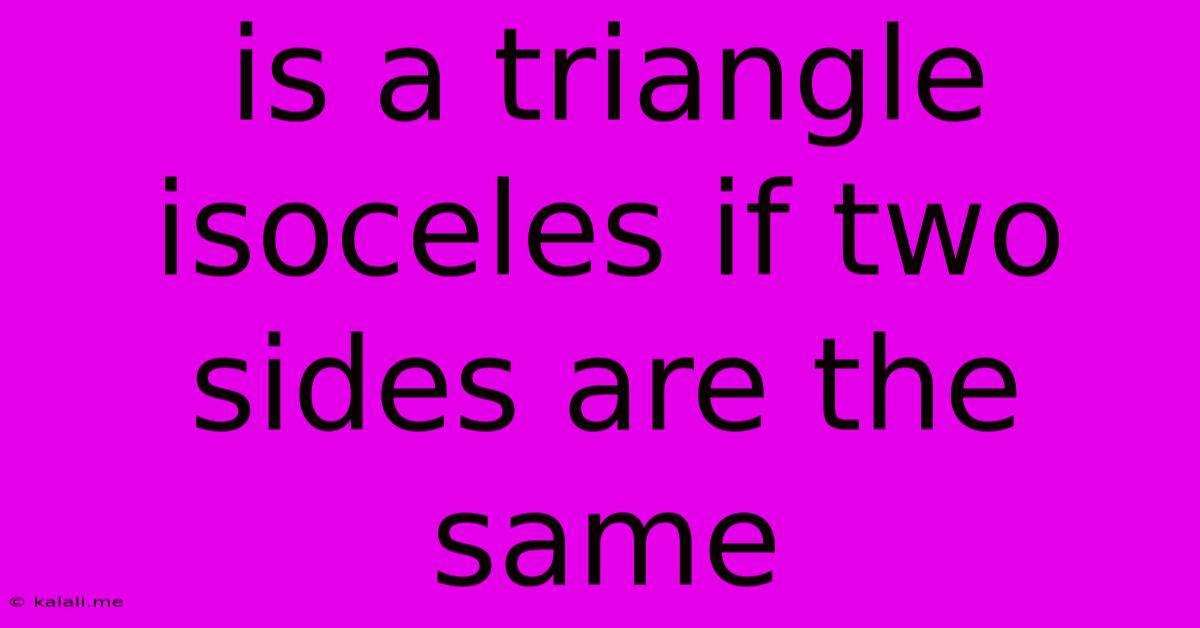Is A Triangle Isoceles If Two Sides Are The Same
Kalali
Jun 07, 2025 · 3 min read

Table of Contents
Is a Triangle Isosceles if Two Sides are the Same? A Definitive Answer
Meta Description: Understanding isosceles triangles? This article definitively answers whether a triangle is isosceles if it has two equal sides, exploring the definition and properties of isosceles triangles.
An isosceles triangle is a fundamental concept in geometry, and understanding its properties is crucial for various mathematical applications. Many students initially grapple with the definition, leading to questions like: "Is a triangle isosceles if two sides are the same?" The simple answer is a resounding yes.
Defining an Isosceles Triangle
An isosceles triangle is defined as a triangle with at least two sides of equal length. These equal sides are called the legs, and the angle between them is called the vertex angle. The third side, which may or may not be equal in length to the legs, is called the base.
It's important to emphasize the "at least two" part of the definition. This means that while an equilateral triangle (with all three sides equal) is a special case of an isosceles triangle, the definition encompasses triangles with exactly two equal sides. This distinction is often a source of confusion.
Properties of Isosceles Triangles
Besides having two equal sides, isosceles triangles exhibit several key properties:
- Two equal angles: The angles opposite the two equal sides (the base angles) are also equal. This is a crucial theorem in geometry, often used in proofs and problem-solving.
- Line of symmetry: An isosceles triangle possesses a line of symmetry that bisects the vertex angle and is perpendicular to the base. This line of symmetry divides the triangle into two congruent right-angled triangles.
- Altitude, median, and angle bisector: The altitude (perpendicular line from the vertex to the base), median (line segment from the vertex to the midpoint of the base), and angle bisector (line segment bisecting the vertex angle) all coincide in an isosceles triangle. This property simplifies many geometric calculations.
Examples and Non-Examples
To solidify understanding, let's consider some examples and non-examples:
Examples of Isosceles Triangles:
- A triangle with sides of length 5, 5, and 7.
- An equilateral triangle with sides of length 10, 10, and 10.
- A triangle with sides of length x, x, and y (where x ≠ y).
Non-Examples of Isosceles Triangles (Scalene Triangles):
- A triangle with sides of length 3, 4, and 5. (This is a right-angled triangle, but not isosceles.)
- A triangle with sides of length 6, 8, and 10. (This is also a right-angled triangle, but not isosceles.)
- A triangle with sides of length 2, 3, and 4.
Conclusion
In conclusion, the answer to the question, "Is a triangle isosceles if two sides are the same?" is an unequivocal yes. The definition of an isosceles triangle explicitly states that it must have at least two equal sides. Understanding this definition and the inherent properties of isosceles triangles is fundamental to mastering geometric concepts and problem-solving. Remember, the presence of two equal sides is the defining characteristic of an isosceles triangle.
Latest Posts
Latest Posts
-
Brake Pedal Makes Noise When Released
Jun 07, 2025
-
Copy Table From One Database To Another
Jun 07, 2025
-
Are Singular Values The Same As Eigenvalues
Jun 07, 2025
-
C S Lewis The Great Divorce
Jun 07, 2025
-
What Does A Catholic Believe About Salvation
Jun 07, 2025
Related Post
Thank you for visiting our website which covers about Is A Triangle Isoceles If Two Sides Are The Same . We hope the information provided has been useful to you. Feel free to contact us if you have any questions or need further assistance. See you next time and don't miss to bookmark.